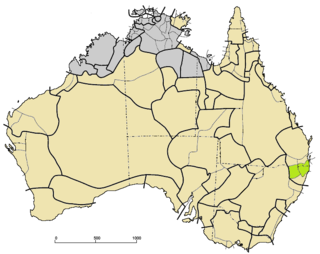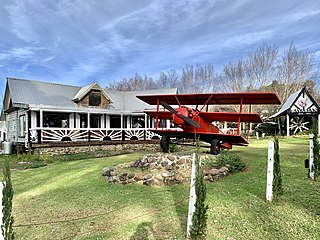
The Logan River is a perennial river located in the Scenic Rim, Logan and Gold Coast local government areas of the South East region of Queensland, Australia. The 184-kilometre (114 mi)-long river is one of the dominant waterways in South East Queensland that drains the southern ranges of the Scenic Rim and empties into Moreton Bay after navigating the City of Logan, a major suburban centre located south of Brisbane. The catchment is dominated by urban and agricultural land use. Near the river mouth are mangrove forests and a number of aquaculture farms.

The Albert River is a perennial river located in the South East region of Queensland, Australia. Its catchment lies within the Gold Coast and Scenic Rim Region local government areas and covers an area of 782 square kilometres (302 sq mi). The river provides potable water for the town of Beaudesert.

Yugambeh, also known as Tweed-Albert Bandjalang, is an Australian Aboriginal language spoken by the Yugambeh living in South-East Queensland between and within the Logan River basin and the Tweed River basin, bounded to the east by the Pacific Ocean and in the west by the Teviot Ranges and Teviot Brook basin.
Yugambal, or Yugumbil (Jukambil), is an Australian Aboriginal language of northern New South Wales.

The history of the Gold Coast in Queensland, Australia began in prehistoric times with archaeological evidence revealing occupation of the district by indigenous Australians for at least 23,000 years. The first early European colonizers began arriving in the late 1700s, settlement soon followed throughout the 19th century, and by 1959 the town was proclaimed a city. Today, the Gold Coast is one of the fastest-growing cities in Australia.

Yugambeh–Bundjalung, also known as Bandjalangic, is a branch of the Pama–Nyungan language family, that is spoken in north-eastern New South Wales and South-East Queensland.
Billy Drumley (1853–1951) was an Aboriginal Australian community leader whose regular long-distance walk was commemorated in a pilgrimage.

Tamborine Mountain is a plateau and locality in the Scenic Rim Region, Queensland, Australia. In the 2016 census, Tamborine Mountain had a population of 7,506 people.
Githabul, also known as Galibal, Dinggabal, and Condamine – Upper Clarence Bandjalang, is an Australian Aboriginal language spoken by the Githabul living in South Queensland and North-East New South Wales.

Mundoolun is a rural locality in the City of Logan, Queensland, Australia. In the 2016 census, Mundoolun had a population of 1,551 people.
Lower Beechmont is a locality in the City of Gold Coast, Queensland, Australia. It is situated in the Gold Coast hinterland. In the 2016 census, Lower Beechmont had a population of 1,046 people.

The Yugambeh ( YOO-gum-BERR, also known as the Minyangbal ( MI-nyung-BUHL, or Nganduwal ( NGAHN-doo-WUL.are an Aboriginal Australian people of south-east Queensland and the Northern Rivers of New South Wales, their territory lies between the Logan and Tweed rivers. A term for an Aboriginal of the Yugambeh tribe is Mibunn, which is derived from the word for the Wedge-tailed Eagle. Historically, some anthropologists have erroneously referred to them as the Chepara, the term for a first-degree initiate. Archaeological evidence indicates Aboriginal people have occupied the area for tens of thousands of years. By the time European colonisation began, the Yugambeh had a complex network of groups, and kinship. The Yugambeh territory is subdivided among clan groups with each occupying a designated locality, each clan having certain rights and responsibilities in relation to their respective areas.
The Kombumerri clan are one of nine distinct named clan estate groups of the Yugambeh people and the name refers to the Indigenous people of the Nerang area on the Gold Coast, Queensland. Australia
The Geynyon, also written Keinjan, are an indigenous Australian people of southern Queensland. According to research done by Queensland South Native Title Services (QSNTS) entitled South East Regional Research Project (SERRP) 'Geynyan' are in all likelihood an dialect/estate group of the wider Githabul peoples. In May 2021 the Githabul peoples lodged a Native Title claim over much of the former Warwick Shire within the Southern Downs Regional Council area.
Waalubal (Wahlubal), also known as Western Bundjalung, Baryulgil, and Middle Clarence Bandjalang, is an Australian Aboriginal language spoken by the Western Bundjalung living in North-East New South Wales.
The Mununjali clan are one of nine distinct named clan estate groups of the Yugambeh people, an Aboriginal Australian nation whose traditional lands are the Beaudesert area in the Scenic Rim, Queensland, Australia.
Margaret Clare Sharpe is a linguist of Australian Aboriginal languages, specializing in Yugambeh-Bundjalung languages, with particular regard to Yugambir, She has also done important salvage fieldwork on the Northern Territory Alawa language.
The Tulgiginclan are one of nine distinct named clan estate groups of the Yugambeh people and the name refers to the Indigenous people of the Tweed area in the Tweed Shire, New South Wales, Australia.
The Gugigin clan are one of nine distinct named clan estate groups of the Yugambeh people and the name refers to the Indigenous people of the Logan area, Queensland, Australia.

Ysola Mary Best was an Australian author and elder of the Yugambeh people. Best is known for her works and role in preserving the language, history and culture of the Yugambeh. She wrote about aboriginal culture and history. Most of her published works are about the Yugambeh language group of South East Queensland.









